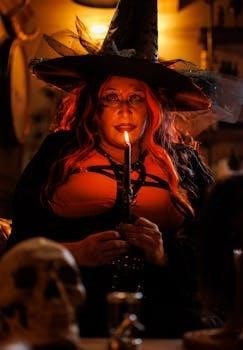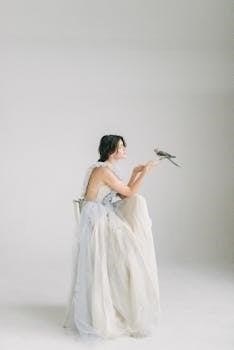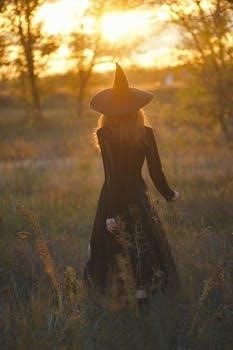List in a Fancy Witchcraft Guide⁚ Unveiling Cursive Curses

The New York Times crossword puzzle presented a unique clue⁚ “List in a fancy witchcraft guide?” The answer, a 13-letter word, was revealed to be “CURSIVECURSES․” This intriguing solution blends calligraphy with the mystical arts, hinting at elaborate spellbooks․
Modern witchcraft guides have surged in popularity, reflecting a broader cultural fascination with magic and spirituality․ These guides, unlike their historical counterparts, often emphasize self-empowerment, personal growth, and a connection to nature․ They cater to a diverse audience, from beginners curious about Wicca to experienced practitioners seeking to deepen their craft․ A key element found within is the art of crafting spells and incantations, often presented with visually appealing aesthetics and detailed instructions․ These guides are available in various formats, including books, online courses, and even interactive apps, ensuring accessibility for all who seek knowledge․
Furthermore, modern witchcraft guides frequently incorporate elements of feminism and social justice, aligning with contemporary values․ They provide a safe space for individuals to explore their spirituality without judgment, fostering a sense of community and belonging․ The guides also delve into the historical context of witchcraft, dispelling myths and misconceptions while celebrating the rich heritage of magical traditions․ Whether you’re interested in potion-making, divination, or simply understanding the symbolism behind witchcraft, there’s a guide tailored to your specific interests․
The New York Times Crossword Clue⁚ Cursivecurses
On June 6, 2024, The New York Times crossword puzzle presented a particularly intriguing clue⁚ “List in a fancy witchcraft guide?” The answer, a 13-letter word, was “CURSIVECURSES․” This solution cleverly combines the visual elegance of cursive handwriting with the mystical connotations of curses, suggesting a beautifully inscribed list of spells or incantations within a witchcraft guide․ The clue itself is a testament to the puzzle’s cleverness, challenging solvers to think creatively and connect seemingly disparate concepts․
The appearance of “CURSIVECURSES” in the crossword highlights the increasing mainstream interest in witchcraft and magic․ The fact that such a niche term would be included in a widely circulated puzzle indicates a growing cultural awareness and acceptance of these practices․ Crossword puzzles often reflect current trends and cultural phenomena, and the inclusion of this clue is a nod to the rising popularity of modern witchcraft and its representation in popular culture․ For crossword enthusiasts and those interested in witchcraft alike, this clue provided a unique and memorable challenge․
Deciphering Cursive Curses in Witchcraft
The term “cursive curses” evokes images of ancient spellbooks filled with elegantly written, yet potent, incantations․ In the context of witchcraft, cursive, with its flowing and interconnected letters, might represent the interconnectedness of energy and intention required to cast a successful spell․ The act of writing a curse in cursive could be seen as a way to imbue it with additional power, as the deliberate and artful strokes focus the witch’s will․
Deciphering these cursive curses would require not only linguistic skills but also a deep understanding of witchcraft lore․ The specific symbols, phrases, and even the way the letters are formed could hold clues to the curse’s purpose, target, and duration․ Furthermore, the choice of ink, parchment, and writing instrument could all contribute to the curse’s overall potency and complexity․ These meticulously crafted curses represent a potent blend of artistry and arcane knowledge․
Witchcraft as Self-Affirmation and Feminism
In contemporary culture, witchcraft has emerged as a powerful avenue for self-affirmation and feminist expression․ For many modern practitioners, witchcraft is not about casting harmful spells but rather about reclaiming personal power, embracing intuition, and connecting with the natural world․ It’s a way to challenge patriarchal norms and celebrate feminine strength and wisdom․
The rituals, spells, and practices associated with witchcraft can be seen as tools for self-discovery and empowerment․ By engaging in these activities, individuals can tap into their inner resources, set intentions, and manifest positive change in their lives․ Furthermore, the emphasis on community and collaboration within many witchcraft traditions fosters a sense of belonging and mutual support, particularly for women who have historically been marginalized or oppressed․ Witchcraft, in this context, becomes a form of resistance and a celebration of female agency․
The Emergence of Modern Witches
Modern witches have stepped out of the shadows, embracing technology and online platforms to connect, share knowledge, and offer their services․ Unlike the stereotypical image of witches lurking in dark alleys, today’s practitioners are often found online, providing readings, spells, and guidance to those seeking their assistance․ This accessibility has contributed to the resurgence of witchcraft as a spiritual path and a form of self-expression․

The internet has become a hub for modern witches, fostering communities where individuals can learn about different traditions, exchange ideas, and find support․ This digital landscape has also enabled witches to offer their services to a wider audience, breaking down geographical barriers and making witchcraft more accessible to those who may not have found it otherwise․ The emergence of modern witches reflects a shift in societal attitudes towards spirituality and a growing interest in alternative belief systems․
Finding Witchcraft Services Online
In the modern era, seeking witchcraft services has evolved beyond traditional methods, with the internet becoming a primary resource․ Today, individuals can easily find a variety of services offered by modern witches online, ranging from spellcasting to tarot readings and personalized rituals․ This accessibility has transformed the landscape of witchcraft, making it more convenient for those seeking guidance or assistance in various aspects of their lives․
However, it is important to exercise caution when seeking witchcraft services online; Not all practitioners are created equal, and it is essential to research and vet potential providers before engaging their services․ Look for reviews, testimonials, and credentials to ensure that you are working with a reputable and ethical practitioner․ While the internet offers convenience and accessibility, it also presents the risk of encountering fraudulent or unreliable individuals․ Therefore, due diligence is crucial when exploring witchcraft services online to ensure a positive and meaningful experience․
Historical Context of Witchcraft
The history of witchcraft is rich and complex, spanning across cultures and centuries․ Witchcraft is an ancient practice found throughout the world․ Its roots trace back to various ancient cultures․ These cultures include ancient pagan traditions, folk beliefs, and early forms of spirituality․ In many societies, witchcraft was intertwined with everyday life, used for healing, divination, and connecting with the natural world․ The perception of witchcraft varied across different cultures, with some viewing it as a positive force while others considered it dangerous or malevolent․

During the Middle Ages and early modern period, Europe witnessed a surge in witch hunts, fueled by religious and social anxieties․ These witch hunts resulted in the persecution and execution of countless individuals, primarily women, who were accused of practicing witchcraft․ The historical context of witchcraft provides valuable insights into the evolution of human beliefs, fears, and societal structures․ It highlights the importance of understanding the historical and cultural factors that shaped the perception and practice of witchcraft throughout history․
Witchcraft in Pop Culture and Literature

Witchcraft has become a pervasive theme in pop culture and literature, evolving from its historical roots into a multifaceted symbol․ In contemporary media, witches are often depicted as powerful figures, embracing self-affirmation and feminist ideals․ This portrayal contrasts with earlier stereotypes, presenting witches as free-spirited individuals who challenge societal norms․ The rise of witchcraft in pop culture reflects a growing interest in spirituality and personal empowerment․
Literature has also played a significant role in shaping the perception of witchcraft․ From classic fairy tales to modern fantasy novels, witches have been portrayed in various lights, ranging from malevolent villains to misunderstood heroines․ Authors explore themes of magic, power, and the occult, often using witchcraft as a metaphor for societal issues and personal struggles․ The enduring appeal of witchcraft in pop culture and literature underscores its ability to capture the imagination and resonate with contemporary audiences․
The Allure of Witchcraft and Magic
The enduring allure of witchcraft and magic stems from a deep-seated human fascination with the unknown and the desire to influence the world around us․ Throughout history, people have sought ways to tap into hidden forces and harness supernatural powers․ Witchcraft, with its rituals, spells, and connection to nature, offers a framework for exploring these mystical realms․
Magic, in its various forms, provides a sense of agency and control in a world that often feels unpredictable․ Whether through ancient traditions or modern interpretations, the practice of magic empowers individuals to manifest their desires and create positive change․ The allure of witchcraft also lies in its ability to challenge conventional beliefs and offer alternative perspectives on reality․ As a counter-cultural movement, it celebrates individuality, intuition, and the power of the human spirit․
